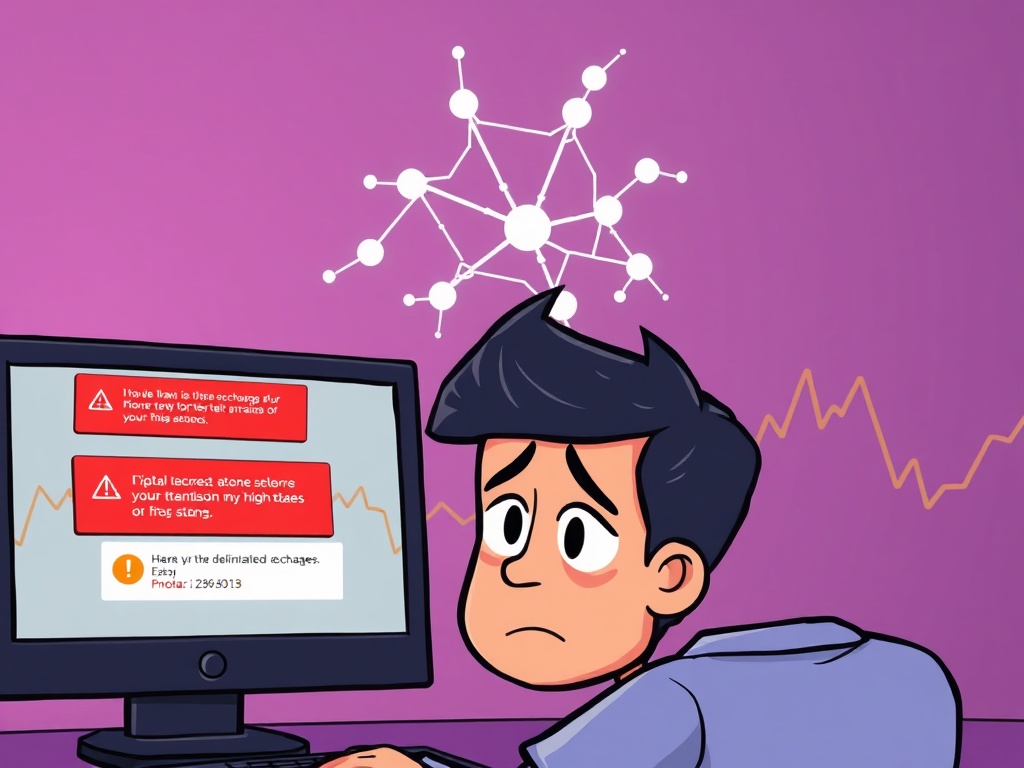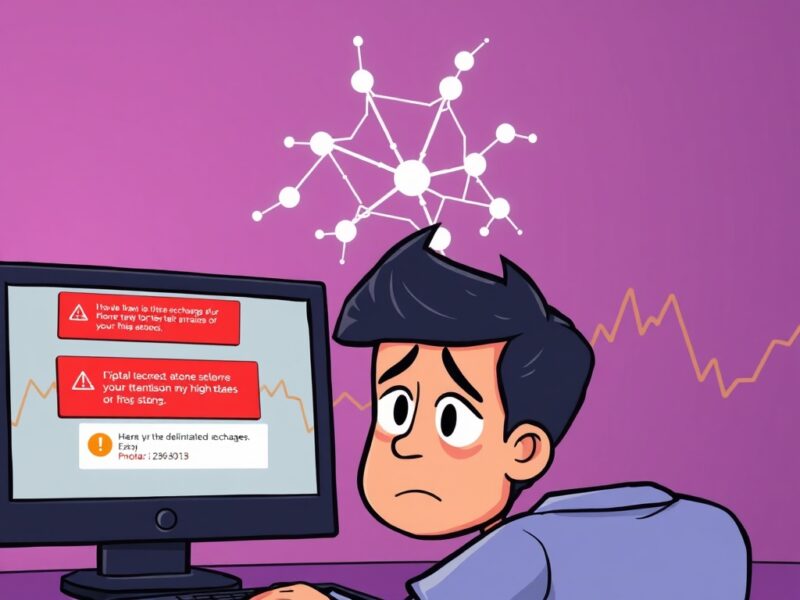BitcoinWorld

Hyperliquid Issues: Unpacking Critical Order and Liquidation Failures
In the fast-paced world of decentralized finance (DeFi), where every second can mean the difference between profit and loss, news of platform malfunctions can send ripples of concern through the community. Recently, users of Hyperliquid, a prominent decentralized perpetual futures exchange, reported alarming Hyperliquid issues, specifically experiencing difficulties with order placement and liquidation processes. This incident, initially brought to light by Wu Blockchain on X, has ignited discussions about the resilience and reliability of DEX platforms.
What Exactly Happened: Unpacking the Recent Hyperliquid Issues?
The core of the recent concern revolves around reports from numerous Hyperliquid users who found themselves unable to execute critical trading actions. Imagine being in a volatile market, needing to close a position to mitigate losses or capitalize on a gain, only to find your commands unresponsive. That’s precisely the frustrating scenario many faced.
According to Wu Blockchain’s report, the decentralized perpetual futures exchange, known by its token HYPE, was suspected of malfunctioning. Users detailed their inability to:
- Place New Orders: Preventing them from entering desired trades.
- Close Existing Positions: Trapping them in trades that could be rapidly moving against them.
- Prevent Liquidations: Inability to add margin or close positions, leading to forced liquidations at unfavorable prices.
The immediate aftermath saw Hyperliquid’s official representatives acknowledge the problem, stating that the issue was under investigation and promising prompt updates. Such incidents, while hopefully temporary, underscore the inherent challenges and risks associated with even the most advanced decentralized trading platforms.
Understanding Hyperliquid: The Appeal of Decentralized Perpetual Futures
Before diving deeper into the technicalities of these Hyperliquid issues, it’s important to understand what Hyperliquid is and why it attracts so many traders. Hyperliquid operates as a decentralized perpetual futures exchange. This means it allows users to trade perpetual contracts – agreements to buy or sell an asset at an unspecified future date – without a centralized intermediary.
The appeal lies in several key aspects:
- Decentralization: Trades are executed directly on the blockchain via smart contracts, reducing reliance on centralized entities and their associated risks (e.g., hacks, regulatory pressures, single points of failure).
- Permissionless Access: Anyone with an internet connection and a crypto wallet can participate, without KYC (Know Your Customer) requirements.
- Self-Custody: Users retain control over their funds in their own wallets, rather than entrusting them to an exchange.
- Leverage Trading: Like traditional futures markets, Hyperliquid offers significant leverage, amplifying potential gains (and losses).
However, the very nature of decentralization also introduces unique complexities. Unlike centralized exchanges (CEXs) that can halt trading during extreme volatility or technical glitches, DEXs operate autonomously based on pre-programmed smart contracts. This autonomy is a double-edged sword; it provides censorship resistance but can make immediate human intervention difficult when unexpected Hyperliquid issues arise.
Here’s a quick comparison of CEX vs. DEX for perpetual futures:
| Feature | Centralized Exchange (CEX) | Decentralized Exchange (DEX) |
|---|---|---|
| Custody | Exchange holds funds | User holds funds (self-custody) |
| KYC | Required | Generally not required |
| Speed | Often faster (off-chain matching) | Can be slower (on-chain settlement) |
| Intervention | Can halt trading, revert transactions | Limited, relies on smart contracts |
| Security Risks | Centralized hacks, regulatory seizure | Smart contract bugs, network congestion |
The Real-World Impact: How Do Hyperliquid Issues Affect Traders?
When a trading platform, especially one dealing with leveraged perpetual futures, experiences malfunctions like those reported on Hyperliquid, the consequences for traders can be severe and immediate. For individuals holding open positions, the inability to manage their trades effectively can lead to significant financial losses. Imagine a scenario where:
- The market suddenly moves against your long position, and you can’t place a stop-loss order or close your trade, leading to a forced liquidation at the lowest point.
- You anticipate a market reversal and want to open a new position, but the system prevents you, causing you to miss out on a profitable opportunity.
- Your margin balance drops, and you try to deposit more funds to avoid liquidation, but the transaction fails to process.
These scenarios highlight the high stakes involved. Beyond financial losses, such Hyperliquid issues can erode user trust, create immense stress, and lead to widespread frustration within the community. For many, DeFi represents a promise of financial freedom and control, and when that promise is undermined by technical glitches, it casts a shadow over the entire ecosystem.
Why Do Technical Issues Occur on Decentralized Platforms Like Hyperliquid?
While the exact cause of the recent Hyperliquid issues is still under investigation, malfunctions on decentralized exchanges can stem from a variety of complex factors unique to blockchain technology:
- Smart Contract Bugs or Vulnerabilities: Even audited smart contracts can contain subtle flaws that manifest under specific conditions, especially during high stress or unique market events. These bugs can affect order matching, liquidation logic, or fund transfers.
- Network Congestion: High transaction volume on the underlying blockchain (e.g., Arbitrum, where Hyperliquid operates) can lead to delays in transaction processing. If the network is congested, orders might not be confirmed in time, leading to failures or liquidations that appear unjust to the user.
- Oracle Malfunctions: Perpetual futures exchanges rely on price oracles to feed real-time market data to their smart contracts. If an oracle provides inaccurate or stale price feeds, it can lead to incorrect liquidations or trade executions.
- Frontend/Backend Desynchronization: Sometimes, the user interface (frontend) might not accurately reflect the true state of the blockchain (backend). This can lead to users believing their orders are placed or closed when, in reality, the transaction hasn’t been confirmed on-chain.
- RPC Node Issues: Decentralized applications (dApps) connect to the blockchain via RPC (Remote Procedure Call) nodes. If these nodes experience downtime or performance issues, it can disrupt communication between the user’s wallet and the dApp, causing transactions to fail.
Pinpointing the precise reason for the Hyperliquid issues requires thorough technical analysis, which the platform’s team is currently undertaking.
Hyperliquid’s Response and What Comes Next
In the wake of the reported malfunctions, Hyperliquid’s official representatives quickly acknowledged the situation. Their statement confirmed that the issue was under investigation and that updates would be shared promptly. This rapid response is crucial for maintaining user confidence, as transparency and timely communication are paramount in the crypto space.
For affected users, the immediate priority is clarity on what transpired, how their positions were impacted, and whether any recourse or compensation will be offered. For Hyperliquid, the challenge lies in not only resolving the immediate technical glitch but also in reinforcing the platform’s reliability and security in the long term. This might involve:
- Detailed post-mortem reports explaining the root cause of the Hyperliquid issues.
- Implementation of additional stress tests and security audits.
- Enhancements to infrastructure to handle extreme market conditions.
- Clear communication channels for users to report issues and seek support.
The crypto community will be watching closely to see how Hyperliquid navigates this challenge and strengthens its platform against future incidents.
Protecting Your Trades: Actionable Insights for DEX Users Amidst Potential Hyperliquid Issues
While platforms like Hyperliquid strive for perfection, the decentralized nature of DeFi means users must always be vigilant. Here are some actionable insights for traders to mitigate risks, especially when facing potential Hyperliquid issues or similar problems on other DEXs:
- Start Small and Understand the Risks: Especially with leveraged trading, begin with smaller amounts until you are fully comfortable with the platform’s mechanics and the inherent risks.
- Utilize Stop-Loss Orders (When Available): If the platform allows, always set stop-loss orders to automatically close your position if the price moves against you beyond a certain point. However, be aware that in highly volatile or illiquid conditions, or during system malfunctions, stop-loss orders may not execute at the exact desired price.
- Monitor Official Channels Constantly: Follow the official social media accounts (like X/Twitter) and announcement channels of the platforms you use. This is often where critical updates about technical issues or maintenance are first shared.
- Diversify Your Platforms: Avoid putting all your capital into a single exchange or trading strategy. Spreading your trades across multiple reputable platforms can reduce your exposure to a single point of failure.
- Understand Smart Contract Interactions: Before engaging with a DEX, take the time to understand how it interacts with your wallet and the blockchain. Familiarize yourself with gas fees and transaction speeds.
- Have an Emergency Plan: In case of platform unresponsiveness, know how to revoke smart contract approvals or interact directly with the underlying blockchain if necessary (though this is highly technical).
- Check Network Status: Before making critical trades, check the status of the underlying blockchain network (e.g., Arbitrum’s status page) for congestion or outages.
The Broader Implications for DeFi: Building Trust and Resilience
Incidents like the Hyperliquid issues, while challenging, serve as critical learning experiences for the entire DeFi ecosystem. They highlight the ongoing need for robust infrastructure, rigorous testing, and transparent communication. For DeFi to achieve mainstream adoption, it must demonstrate not only innovation but also unwavering reliability and security.
Every time a decentralized platform faces and successfully resolves a significant technical challenge, it contributes to the collective knowledge base and helps strengthen the ecosystem. It pushes developers to build more resilient systems, encourages users to be more informed, and ultimately, fosters greater trust in the promise of decentralized finance.
Summary: Navigating the Complexities of Decentralized Trading
The recent reports of Hyperliquid issues, involving order and liquidation failures, serve as a stark reminder of the complexities and inherent risks in decentralized perpetual futures trading. While Hyperliquid’s team is actively investigating and addressing the situation, the incident underscores the critical importance of platform stability and transparent communication in the DeFi space. For traders, vigilance, understanding the technology, and implementing robust risk management strategies are paramount. As the decentralized finance landscape continues to evolve, incidents like these are not just setbacks but opportunities for growth, pushing the boundaries of what secure and reliable blockchain-based trading can achieve.
Frequently Asked Questions (FAQs)
What exactly were the Hyperliquid issues reported by users?
Users reported critical malfunctions on the Hyperliquid decentralized exchange, specifically an inability to place new orders, close existing positions, or prevent liquidations. This left many traders unable to manage their leveraged trades effectively.
How common are such order and liquidation failures on decentralized exchanges (DEXs)?
While not an everyday occurrence, technical glitches, network congestion, or smart contract issues can occasionally lead to such failures on DEXs. The decentralized and autonomous nature of these platforms means immediate human intervention is limited compared to centralized exchanges.
What should I do if my order fails or I experience Hyperliquid issues?
First, check Hyperliquid’s official communication channels (e.g., X/Twitter, Discord) for announcements. Document the issue with screenshots or transaction IDs. If possible, attempt to refresh your connection or clear your browser cache. Contact their support if the issue persists and no official solution is announced.
Is Hyperliquid still safe to use after these issues?
Hyperliquid’s team stated they are investigating the issue and will provide updates. The safety of using any platform after an incident depends on the root cause, the resolution implemented, and the platform’s transparency. It’s advisable to monitor official announcements and consider starting with smaller positions if you choose to continue trading.
How can I stay updated on Hyperliquid’s status and future developments?
The best way to stay informed is by following Hyperliquid’s official X (formerly Twitter) account, joining their Discord server, or checking their official blog or announcement channels. These are typically where the most timely and accurate updates are shared regarding any Hyperliquid issues or system improvements.
If you found this article insightful, consider sharing it with your network! Help us spread awareness about important developments and challenges in the decentralized finance space.
To learn more about the latest crypto market trends, explore our article on key developments shaping Bitcoin institutional adoption.
This post Hyperliquid Issues: Unpacking Critical Order and Liquidation Failures first appeared on BitcoinWorld and is written by Editorial Team





